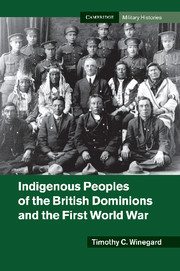Book contents
- Frontmatter
- Contents
- Figures
- Maps
- Tables
- Acknowledgements
- Note on the text
- Introduction
- 1 Colonization and the settler state
- 2 Racial constructs and martial theories
- 3 Precedents of military pragmatism
- 4 Dominion defence acts
- 5 1914: Subjugated spectators
- 6 1915–1916: King and country call
- 7 1917–1918: All the King’s men
- 8 Indigenous soldiers
- 9 The home front
- 10 Peace with prejudice
- Conclusion
- Bibliography
- Index
- References
8 - Indigenous soldiers
Published online by Cambridge University Press: 05 June 2014
- Frontmatter
- Contents
- Figures
- Maps
- Tables
- Acknowledgements
- Note on the text
- Introduction
- 1 Colonization and the settler state
- 2 Racial constructs and martial theories
- 3 Precedents of military pragmatism
- 4 Dominion defence acts
- 5 1914: Subjugated spectators
- 6 1915–1916: King and country call
- 7 1917–1918: All the King’s men
- 8 Indigenous soldiers
- 9 The home front
- 10 Peace with prejudice
- Conclusion
- Bibliography
- Index
- References
Summary
Indigenous peoples participated in all aspects of the war both on and off the battlefields. While racial estimations influenced the standing of indigenes as soldiers, their military participation correspondingly influenced racial perceptions. The exposure of indigenous soldiers to the wider world and their association with soldiers and civilians from other nations altered their perceptions of themselves, their home nations and white countrymen. Racial and martial perceptions of indigenous soldiers were formed, modified or confirmed during the war by all nationalities. Indigenes also formed their own observations and estimations of themselves within the profession of arms, their home Dominions and the broader empire.
Racial perceptions influenced the creation of units, the military trade of certain all-indigenous formations, and the roles and ranks of indigenes. Cynthia Enloe describes this occurrence as a combination of ‘political reliability’ weighed against ‘martial race’ aptitude, whereby each identifiable group was assigned a military occupation (or unit) in keeping with maintaining domestic state security. In summary, a group that possessed martial propensities, and was politically reliable (assimilated), such as the Maori, was trusted to perform a military function, usually reserved for whites, within a homogenous unit under their own officers. Those deemed high on the martial scale but lower on the reliability/assimilation scale, were relegated to combat support occupations, in homogenous units, strictly controlled and segregated by white officers and NCOs, such as the SANLC. Thus, homogenous units occurred at both ends of the spectrum, the difference being the race of those ranks entrusted with command and control, and whether the formation’s function was combatant or auxiliary. The possibility existed of groups that were highly martial but politically unreliable being excluded wholesale, if they had recently rebelled. This was the perception of many South Africans in relation to the use of blacks in any military capacity, especially the Zulu who had rebelled in 1906.
- Type
- Chapter
- Information
- Publisher: Cambridge University PressPrint publication year: 2011



